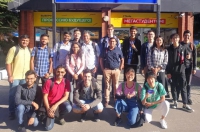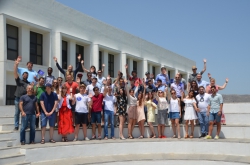Getting such a tour is not as difficult as it may seem, as the laboratory regularly conducts organized tours. A ticket can be booked on the laboratory's website; yet, one will have to wait several months before actually visiting CERN, as there are lots of people who want to see this advanced facility with their own eyes.

As of now, more than 20 countries take part in CERN's research; that would be more than 10,000 physicists and engineers from 580 different universities. The laboratory lies on the border of Switzerland and France and occupies several kilometers of space, so the staff use buses to get from one building to another. Actually, CERN is in some way similar to a full-fledged city: it has all the facilities to make scientists feel at home.
According to Stephan Zellner, a young scientist who works on the ELENA experiment, CERN feels really empty and quiet in December: during winter, most experiments are frozen, and scientists spend their time preparing their reports or leave for their homes. This also has to do with high electricity costs: most of CERN's equipment consumes as much energy in a month than half of a small town.

Stephan has been working for the laboratory for a year and a half already. The ELENA installation is a coil for cooling and slowing antiprotons in CERN's Antiproton Decelerator. The experiment started in 2000 and ended only a couple months ago; its results allow to conduct precise comparisons of properties of matter and antimatter. There were pecularities to this experiment, as well. For instance, the scientists noticed some anomalies in ELENA's operation. As it turned out, the reason behind the problem was a working air conditioner. Yet, even such small details can lead to actual discoveries.

"Actually, it's hard to get access to an accelerator even if you're working for CERN. First of all, you'd have to sign a contract where you state that you understand the possible hazards. Secondly, anyone working with it has to carry a device for measuring radiation levels which is fixed with a special tag that grants access to the installation. And even that won't work if the data from your retina scan and weight would differ from what is recorded in your profile", comments Mr. Zellner.

Even after passing several security checks, a staff member only gains access to a limited number of devices. The most important facility is the Large Hadron Collider. This is one of the biggest installations of the laboratory, and the largest and most complex experimental facility ever built. Unfortunately, access to the collider is restricted to common visitors, so seeing it during a tour would be impossible. Yet, if you really want to immerse yourself in CERN's work, you can take part in its summer schools that are aimed at highschoolers and university students, as well as scientists and university professors.





